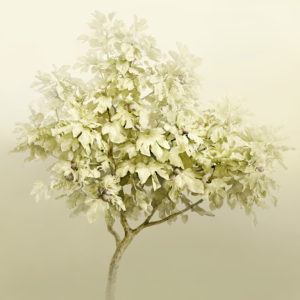6/24/2017 Arborealism: Irene Kung’s tree photography | Art | santafenewmexican.com
Arborealism: Irene Kung’s tree photography
Michael Abatemarco, June 16, 2017

Whether it’s animals, mountains, clouds, trees, ancient cities, or modern architecture, photographer Irene Kung brings an emphasis to the beauty of
forms in her photography, removing background imagery to focus the viewer’s attention on a single subject. In Trees, an exhibit of recent largeformat
digital photos on view at Chiaroscuro Contemporary Art, Kung gives viewers the sense of an enchanted landscape. The trees have a personality and
presence that is enhanced by Kung’s manipulations. To stand before one and really see it, you have to filter out what surrounds you, vying for your
attention, and then you can experience the trees not as objects — one among a forest of many — but as beings.
Kung, who was born and lives in Switzerland, moves beyond traditional landscape photography or cityscape photography in her work, which feels less
about place than about encounters. Kung digitally removes details in her compositions, which combine sharp resolution and soft focus; the subject
appears to emerge from dark or light surroundings. When isolated, you can more readily see and appreciate the symmetry of the mysterious trees. Each of the seven images on display bear a common or scientific name for the tree depicted. In Albero della Vita, an image that appears at least twice in her repertoire — one in a setting of white, the other of black — offers an interesting look at contrast in background tones and how they affect the appearance of the subject. In the darker image, Albero della Vita 1, the leafless tree is skeletal white, seeming to pop out at you with remarkable vividness while at the same time drawing you in. It was shot in daylight but processed to appear like a nighttime photograph, with illumination that appears supernatural. In the lighter image, Albero della Vita 2, the tree itself is darker, silhouetted against a atmospheric white sky that suggests winter.
Another image, Albero Neve (Snow Tree), is a more explicit evocation of winter, as the tree’s branches are laden with snow. There is a sense
of something wild in the windswept, blanketed form, but the shape is also cohesive. The tree is ravaged by the elements; nevertheless it endures. The
large scale of Kung’s photographs allows the visitor to experience each tree at a human level, but the photos are also large enough to convey the
trees’ stately and majestic spirits.
Trees is part of a larger body of Kung’s work called Forest of the Soul. Also in the series is a group of photos focused on animals — particularly, but not
exclusively, horses. Not only do these images, several of which are portraits of animal faces, underscore the diversity between and within species, but
they also capture their personalities, as though going beyond mere representation of the creatures to get at their souls.
Kung, who studied as a painter before turning to photography, brings a painter’s sense of composition to her images. For instance, Fico 2, one of the
most recent images in the series, looks as though it could be a watercolor or illustration. The natural colors of the pale green vegetation give way to white, the green becoming more muted around the edges of the central form. Her Gomero, of a squat baobablike
tree, is full of sharp detail, like a landscape rendered by the hand of Henri Rousseau, but it has a magic quality, as though it is the kind of tree you might find in a fairyland. It’s the perfect setting for the Cheshire Cat, or perhaps a satyr, hidden in the leaves and branches.
Divorced from their landscape contexts, many of Kung’s photographs are, in a sense, abstractions. Where outer edges of the forms she shoots vanish
into the light, or into the night, she sometimes accentuates only a section of them, whether trees or other subjects. But when shooting in black and white, as she sometimes does, or in color, her digital manipulations create new contexts. This can be seen particularly in her architecturebased
imagery, where a single building is isolated from the surrounding cityscape, appearing otherworldly or dreamlike. These images of humanbuilt
environments have more in common with her natural subjects in their presentation than you may expect. The buildings, too, have a sense of character or a soul, and as with the trees, sensuous, curving linear details and balance are among their formal attributes.
What Kung does for the trees is effectively allow them to speak, and what they seem to speak of is their longevity, their semipermanence,
and all that they have witnessed in the decades and centuries of their existences. A person who encounters an animal in the wild might appreciate that the beast is sizing him or her up just as curiously as the human watching it. Trees, however, are things we feel aware of in a different way, that we regard with a different sensibility than the one with which we regard sentient beings. Still, one leaves Kung’s Trees with a more profound sense of the woody perennials’ existence as living forms. The sentinels of the forest are watching.
